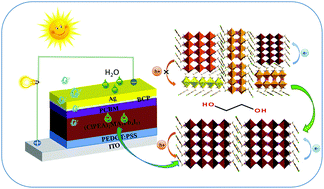Our official English website, www.x-mol.net, welcomes your feedback! (Note: you will need to create a separate account there.)
Controlling layered Ruddlesden–Popper perovskites via solvent additives
Nanoscale ( IF 6.7 ) Pub Date : 2020/03/09 , DOI: 10.1039/c9nr10382a Han Pan 1, 2, 3, 4, 5 , Xiaojuan Zhao 1, 2, 3, 4, 5 , Gong Xiu 1, 2, 3, 4, 5 , Hao Li 6, 7, 8, 9 , Xiao Li Zhang 5, 10, 11, 12 , Guijie Liang 5, 13, 14, 15 , Yan Shen 1, 2, 3, 4, 5 , Mingkui Wang 1, 2, 3, 4, 5
Nanoscale ( IF 6.7 ) Pub Date : 2020/03/09 , DOI: 10.1039/c9nr10382a Han Pan 1, 2, 3, 4, 5 , Xiaojuan Zhao 1, 2, 3, 4, 5 , Gong Xiu 1, 2, 3, 4, 5 , Hao Li 6, 7, 8, 9 , Xiao Li Zhang 5, 10, 11, 12 , Guijie Liang 5, 13, 14, 15 , Yan Shen 1, 2, 3, 4, 5 , Mingkui Wang 1, 2, 3, 4, 5
Affiliation

|
Layered Ruddlesden–Popper (RP) phase perovskites, with a formula of A′2MAn−1Pbn3n+1 (where A′ is an organic cation, MA is methylammonium, n is the integer for the number of inorganic sheets [PbI6] between the organic cation spacers), are of high interest due to their chemical stability. However, the low-n phases (e.g., n = 1, 2) not only act as carrier traps, but also hinder carrier transport within the layered RP perovskites, leading to a decreased photovoltaic performance for their corresponding devices. Herein, we report that a solvent additive-induced Ostwald ripening process effectively promotes the reduction of low-n phases and uniform RP perovskites composition. Note that the solvent added, such as ethylene glycol as an example, should have selective solubility to organic cations, and be less volatile but have a higher boiling point than the host solvents such as N,N-dimethylformamide (DMF). During fast spin-coating at room temperature, the host solvent DMF quickly evaporates while the low-n phase perovskite films are formed due to a smaller nucleation barrier, allowing the contained solvent additive, ethylene glycol, to act as a plasticizer. Then, annealing at 100 °C, causes a slow release of the restrained solvent additive which recrystallizes the perovskite grains with low-n phases into high-n phases (e.g., n ≥3) in the (ClPEA)2MA3Pb4I13 (where ClPEA is 2-(4-chlorophenyl)ethanaminium) layered RP phase perovskites. When used in solar cells, the device with a configuration of ITO/PEDOT:PSS/RP perovskite/PC61BM/BCP/Ag showed an enhanced 11% power conversion efficiency, which can be attributed to the decreased trap-state density and the increased carrier transport induced by the solvent additive.
中文翻译:

通过溶剂添加剂控制分层的Ruddlesden-Popper钙钛矿
层状Ruddlesden-波普(RP)相钙钛矿,随着A的公式“ 2 MA Ñ -1铅Ñ 3 Ñ 1(其中,A'为有机阳离子,MA是甲基铵,Ñ为无机片材的数量的整数有机阳离子间隔基之间的[PbI 6 ]因其化学稳定性而备受关注。然而,低ñ阶段(例如,ñ= 1、2)不仅充当载流子陷阱,还阻碍载流子在层状RP钙钛矿中的运输,从而导致其相应器件的光伏性能下降。本文中,我们报道了溶剂添加剂诱导的奥斯特瓦尔德熟化过程有效地促进了低n相的还原和均匀的RP钙钛矿组成。注意,添加的溶剂,例如乙二醇,应对有机阳离子具有选择性的溶解性,并且比诸如N,N-二甲基甲酰胺(DMF)之类的主体溶剂具有更低的挥发性,但沸点更高。在快旋涂在室温下,主机溶剂DMF迅速蒸发,而低Ñ由于较小的成核壁垒,形成了钙钛矿相膜,使所含的溶剂添加剂乙二醇可用作增塑剂。然后,退火在100℃下,使的缓慢释放抑制溶剂添加剂,其再结晶与低钙钛矿晶粒Ñ相到高Ñ相(例如,Ñ ≥3)在(ClPEA)2 MA 3的Pb 4予13(其中ClPEA是2-(4-氯苯基)乙胺)层状RP相钙钛矿。当用于太阳能电池时,该设备的配置为ITO / PEDOT:PSS / RP钙钛矿/ PC 61BM / BCP / Ag的功率转换效率提高了11%,这可以归因于陷阱态密度的降低和溶剂添加剂引起的载流子传输的增加。
更新日期:2020-04-03
中文翻译:

通过溶剂添加剂控制分层的Ruddlesden-Popper钙钛矿
层状Ruddlesden-波普(RP)相钙钛矿,随着A的公式“ 2 MA Ñ -1铅Ñ 3 Ñ 1(其中,A'为有机阳离子,MA是甲基铵,Ñ为无机片材的数量的整数有机阳离子间隔基之间的[PbI 6 ]因其化学稳定性而备受关注。然而,低ñ阶段(例如,ñ= 1、2)不仅充当载流子陷阱,还阻碍载流子在层状RP钙钛矿中的运输,从而导致其相应器件的光伏性能下降。本文中,我们报道了溶剂添加剂诱导的奥斯特瓦尔德熟化过程有效地促进了低n相的还原和均匀的RP钙钛矿组成。注意,添加的溶剂,例如乙二醇,应对有机阳离子具有选择性的溶解性,并且比诸如N,N-二甲基甲酰胺(DMF)之类的主体溶剂具有更低的挥发性,但沸点更高。在快旋涂在室温下,主机溶剂DMF迅速蒸发,而低Ñ由于较小的成核壁垒,形成了钙钛矿相膜,使所含的溶剂添加剂乙二醇可用作增塑剂。然后,退火在100℃下,使的缓慢释放抑制溶剂添加剂,其再结晶与低钙钛矿晶粒Ñ相到高Ñ相(例如,Ñ ≥3)在(ClPEA)2 MA 3的Pb 4予13(其中ClPEA是2-(4-氯苯基)乙胺)层状RP相钙钛矿。当用于太阳能电池时,该设备的配置为ITO / PEDOT:PSS / RP钙钛矿/ PC 61BM / BCP / Ag的功率转换效率提高了11%,这可以归因于陷阱态密度的降低和溶剂添加剂引起的载流子传输的增加。


























 京公网安备 11010802027423号
京公网安备 11010802027423号